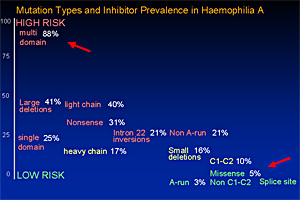Research : Molecular basis of haemophilia A

Molecular basis of haemophilia A
Maria Lim-Eimer, Anni Pavlova, Matthias Watzka (Frankfurt)Claudia Klein, Heike Singer (Bonn)
Clemens Müller-Reible, Jörg Schröder (Würzburg)
Mutation analysis is performed in about 3500 patients from Germany with severe haemophilia A. Obtained genotypic and phenotypic data are registered and correlated with the clinical course of the patients, especially the risk of inhibitor formation. So far we have analysed 1850 patients from 1250 families with haemophilia A. The causative mutation could be identified in 98% of the patients (Klopp et al. 2002). With respect to genotype-phenotype correlation we have identified 11 mutation (sub)types with distinct different risk of inhibitor development, ranging from inhibitor prevalences of 5% in missense mutations to 88% in large deletions (Oldenburg et al. 1998, Oldenburg et al 2004). The main factors driving the risk of inhibitor formation are the presence of endogenous factor VIII protein and the localisation of the mutation within the FVIII gene. Furthermore our data revealed that somatic mosaicisms represent a common mutation origin in haemophilia A and therefore must be considered in genetic counselling (Leuer et al. 2001). The project is supported by an initiative of the German Human Genome Project and funded by the BMBF-DLR.
